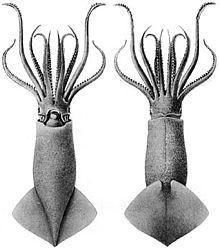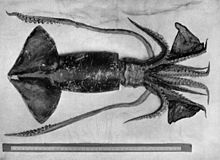| Oegopsida | |
|---|---|
 | |
| Moroteuthis ingens | |
| Scientific classification | |
| Kingdom: | Animalia |
| Phylum: | Mollusca |
| Class: | Cephalopoda |
| Superorder: | Decapodiformes |
| Order: | Oegopsida Orbigny, 1845[1] |
| Families | |
| See text | |
| Synonyms | |
| |
Oegopsida is one of the two orders of squid in the superorder Decapodiformes, in the class Cephalopoda. Together with the Myopsina, it was formerly considered to be a suborder of the order Teuthida, in which case it was known as Oegopsina. This reclassification is due to Oegopsina and Myopsina not being demonstrated to form a clade.[2]
The Oegopsida are an often pelagic squid, with some nerito-oceanic species associated with sea mounts.[3] They consist of 24 families and 69 genera. They have these characters in common: the head is without tentacle pockets, eyes lack a corneal covering, arms and tentacle clubs may have hooks, the buccal supports are without suckers, and oviducts in females are paired.
Two families, the Bathyteuthidae and Chtenopterygidae, which have features characteristic of the Myopsida while retaining others common to the Oegopsina, are sometimes placed in the Bathyteuthoidea.
The Oegopsida differ from the coastal Myopsida, characterised by the genus Loligo, which have corneal coverings over the eyes and tentacle pockets, but lack hooks, have no suckers on the buccal supports, and a single oviduct.
Oegopsid squid are the only decapods that lack a pocket for the tentacles. Otherwise, they share different characters with different decapod groups. Like the Bathyteuthoidea and Myopsida, the Oegopsida have a brachial canal, which is absent in other forms. As with the Spirulidae and Idiosepiidae, the Oegopsida lack suckers on the buccal supports, and like the Bathyteuthoidea, Idiosepiidae, and Spirulidae, they have no circular muscle on the suckers.
- Order Oegopsida
- Family Ancistrocheiridae
- Family Architeuthidae
- Family Bathyteuthidae
- Family Batoteuthidae
- Family Brachioteuthidae
- Family Chiroteuthidae
- Family Chtenopterygidae
- Family Cranchiidae
- Family Cycloteuthidae
- Family Enoploteuthidae
- Family Gonatidae
- Family Histioteuthidae
- Family Joubiniteuthidae
- Family Lepidoteuthidae
- Family Lycoteuthidae
- Family Magnapinnidae
- Family Mastigoteuthidae
- Family Neoteuthidae
- Family Octopoteuthidae
- Family Ommastrephidae
- Family Onychoteuthidae
- Family Pholidoteuthidae
- Family Promachoteuthidae
- Family Psychroteuthidae
- Family Pyroteuthidae
- Family Thysanoteuthidae
- Parateuthis tunicata (incertae sedis)
These families group into a number of different clades but these have not yet been formally given names. These groupings are:[4]
- Architeuthids
- Architeuthidae
- Neoteuthidae
- Brachioteuthids
- Brachioteuthidae
- Chiroteuthids
- Batoteuthidae
- Chiroteuthidae
- Joubiniteuthidae
- Magnapinnidae
- Mastigoteuthidae
- Promachoteuthidae
- Cranchiids
- Cranchiidae
- Cycloteuthids
- Cycloteuthidae
- Enoploteuthids
- Ancistrocheiridae
- Enoploteuthidae
- Lycoteuthidae
- Pyroteuthidae
- Gonatids
- Gonatidae
- Histioteuthids
- Histioteuthidae
- Psychroteuthidae
- Lepidoteuthida
- Lepidoteuthidae
- Octopoteuthidae
- Pholidoteuthidae
- Ommastrephids
- Ommastrephidae
- Onychoteuthids
- Onychoteuthidae
- Thysanoteuthids
- Thysanoteuthidae
References
- ^ Philippe Bouchet (2018). "Oegopsida". World Register of Marine Species. Flanders Marine Institute. Retrieved 22 February 2018.
- ^ Jan M. Strugnell; Annie Lindgren; Louise M. Allcock (2009). "Cephalopod mollusks Cephalopoda". In S. Blair Hedges; Sudhir Kumar (eds.). The Timetree of Life. OUP Oxford. pp. 2–18.
- ^ P., Roper, Clyde F. E., 1937- Jereb (2010). Cephalopods of the world : an annotated and illustrated catalogue of cephalopod species known to date (PDF). Food and Agriculture Organization of the United Nations. ISBN 978-9251053836. OCLC 880299294.
- ^ Young, Richard E. & Michael Vecchione (2016). "Oegopsida Orbigny, 1845. Version 27 February 2016 (under construction)". The Tree of Life Web Project.
External links
